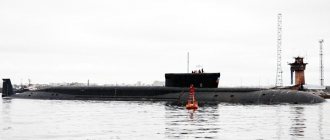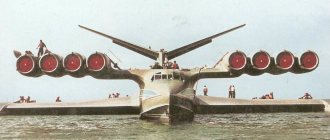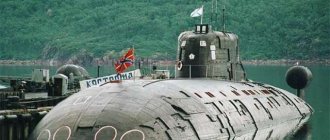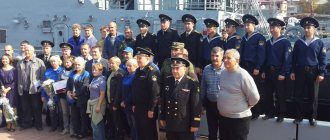| Photo: Vyshinsky Denis/TASS |
On Thursday, the Admiralty Shipyards in St. Petersburg handed over the diesel-electric submarine Krasnodar to the Russian Navy. The Kolpino and Veliky Novgorod submarines will be launched in the spring of 2016.
On November 5, the Admiralty Shipyards handed over the fourth diesel-electric submarine of Project 636.3 (“Varshavyanka”) to the Russian Navy. The Krasnodar submarine became part of the 4th submarine brigade of the Novorossiysk naval base. In total, the Black Sea Fleet should receive six Project 636.3 Varshavyanka submarines.
The second submarine of the Varshavyanka project will be transferred to the Navy on December 30 News
Story
The increased capabilities of hydroacoustic means by the 1970s led to easy detection of submarines by the acoustic field, and Soviet designers began to pay priority attention to noise reduction issues. Since the noise level of Project 641B submarines, which belong to the second generation, could not be reduced, it was decided to build a fundamentally new ship, and therefore the development of a project for diesel submarines began at the Rubin design bureau under the leadership of Yu. N. Kormilitsin third generation. In accordance with the assignment, the designed boat had to be guaranteed to win a duel situation against any submarine of this class, which was achieved by an optimal combination of low noise, detection range, speed and power of weapons.] Initially, the project included great opportunities for subsequent upgrades
.
Construction was carried out in two series, significantly different in characteristics. As part of the USSR Navy, all boats were assigned to project 877, and export ones - one series was designated as project 877E and 877EKM, the second - project 636
.
In 1979, at the plant named after. The lead ship of the project was laid down at the Lenin Komsomol in Komsomolsk-on-Amur, which entered service in 1982. Subsequently, Project 877 ships were produced at shipyards in Leningrad and Gorky
.
Representatives of the series
File:Kilo class SS.svg Project 877 diagram
File:Improved Kilo class SS.svg Project diagram 636
Varshavyanka-class submarines
, combining projects 877 and 636 and their modifications, are the main class of non-nuclear submarines produced in Russia. They are in service with both Russian and a number of foreign fleets. The project, developed in the late 1970s, is considered very successful, so the construction of the series, with a number of improvements, continues in the 2010s.
| Name | Shipyard | Template:abbr | Bookmark | Launching | Commissioning | Fleet | State | Template:abbr |
| Project 636 | ||||||||
| 366 Yuan Zhend 66 Hao | Admiralty Shipyards | 01616 | 16.07.1996 | 26.04.1997 | 26.08.1997 | Chinese Navy | Active | |
| 367 Yuan Zhend 67 Hao | Admiralty Shipyards | 01327 | 28.08.1997 | 18.06.1998 | 25.10.1998 | Chinese Navy | Active | |
| Project 636M | ||||||||
| 368 Yuan Zhend 68 Hao | Admiralty Shipyards | 01329 | 18.10.2002 | 27.05.2004 | 20.10.2004 | Chinese Navy | Active | |
| 369 Yuan Zhend 69 Hao | Admiralty Shipyards | 01330 | 18.10.2002 | 19.08.2004 | 05.2005 | Chinese Navy | Active | |
| 370 Yuan Zhend 70 Hao | Admiralty Shipyards | 01331 | 2004 | 04-05.2005 | 05.2005 | Chinese Navy | Active | |
| 371 Yuan Zhend 71 Hao | Admiralty Shipyards | 01332 | 2004 | 26.05.2005 | 2005 | Chinese Navy | Active | |
| 372 Yuan Zhend 72 Hao | Admiralty Shipyards | 01333 | 2004 | 26.08.2005 | 30.05.2006 | Chinese Navy | Active | |
| 373 Yuan Zhend 73 Hao | Krasnoe Sormovo | 01611 | 07.1992 | 08.05.2004 | 05.08.2005 | Chinese Navy | Active | |
| 374 Yuan Zhend 74 Hao | Sevmash | 01701 | 29.05.2003 | 05/21/2005 (Template:abbr) | 11/17/2005 (Template:abbr) | Chinese Navy | Active | |
| 375 Yuan Zhend 75 Hao | Sevmash | 01702 | 29.05.2003 | 07/14/2005 (Template:abbr) | 11/24/2005 (Template:abbr) | Chinese Navy | Active | |
| 021 Messali el Hadj | Admiralty Shipyards | 01336 | 2006 | 20.11.2008 | 28.08.2009 | Algerian Navy | Active | |
| 022 Akram Pacha | Admiralty Shipyards | 01337 | 2007 | 09.04.2009 | 29.10.2010 | Algerian Navy | Active | |
| Project 636.1 | ||||||||
| HQ-182 Hà Nội ("Hanoi") | Admiralty Shipyards | 01339 | 24.08.2010 | 28.08.2012 | Template:abbr Template:abbr | Vietnam Navy | Active | |
| HQ-183 Hồ Chí Minh ("Ho Chi Minh City") | Admiralty Shipyards | 01340 | 28.09.2011 | 28.12.2012 | Template:abbr Template:abbr | Vietnam Navy | Active | |
| HQ-184 Hải Phòng ("Haiphong") | Admiralty Shipyards | 01341 | 23.10.2012 | 28.08.2013 | Template:abbr Template:abbr | Vietnam Navy | Active | |
| HQ-185 Khánh Hòa (“Khanh Hoa”) | Admiralty Shipyards | 01342 | 23.10.2012 | 28.03.2014 | Template:abbr Template:abbr | Vietnam Navy | Active | |
| HQ-186 Đà Nẵng ("Danang") | Admiralty Shipyards | 01343 | 01.07.2013 | 28.12.2014[21] | Template:abbr Template:abbr | Vietnam Navy | Active | |
| HQ-187 Bà Rịa–Vũng Tàu ("Vung Tau") | Admiralty Shipyards | 01344 | 28.05.2014 | 28.09.2015[22] | Template:abbr Template:abbr | Vietnam Navy | Active[23] | |
| 031 Ouarsenis | Admiralty Shipyards | 01346 | 2015[24] | 14.03.2017 | Template:abbr Template:abbr | Algerian Navy | Active[25] | |
| 032 Hoggar | Admiralty Shipyards | 01347 | 2016[24] | 29.06.2017[26] | Template:abbr Template:abbr | Algerian Navy | Active[27][28] | |
| n/a | Admiralty Shipyards | 01348 | 2018 | 2018 | Indian Navy | The possibility of construction is being considered[29] | ||
| n/a | Admiralty Shipyards | 01349 | 2018 | 2018 | Indian Navy | The possibility of construction is being considered[29] | ||
| Project 636.3 | ||||||||
| B-261 "Novorossiysk" | Admiralty Shipyards | 01670 | 20.08.2010 | 28.11.2013 | 17.09.2014 | In service | 09/21/2015 arrived in Novorossiysk | |
| B-237 "Rostov-on-Don" | Admiralty Shipyards | 01671 | 21.11.2011 | 26.06.2014 | 30.12.2014 | In service | 12/16/2015 arrived in Novorossiysk | |
| B-262 "Stary Oskol" | Admiralty Shipyards | 01672 | 17.08.2012 | 28.08.2014 | 03.07.2015 | In service | 07/01/2016 arrived in Novorossiysk | |
| B-265 "Krasnodar" | Admiralty Shipyards | 01673 | 20.02.2014 | 25.04.2015 | 05.11.2015 | In service | 08/09/2017 arrived in Sevastopol | |
| B-268 "Veliky Novgorod" | Admiralty Shipyards | 01674 | 30.10.2014 | 18.03.2016 | 26.10.2016 | In service | 10/26/2016 St. Andrew's flag was raised | |
| B-271 "Kolpino" | Admiralty Shipyards | 01675 | 30.10.2014 | 31.05.2016 | 24.11.2016 | In service | 11/24/2016 St. Andrew's flag was raised | |
| B-274 "Petropavlovsk-Kamchatsky" | Admiralty Shipyards | 01614 | 28.07.2017 | 2019 | 11.2020 | Pacific Fleet | Under construction[30] | |
| B-603 "Volkhov" | Admiralty Shipyards | 01615 | 28.07.2017 | 03-05.2020 | 11.2020 | Pacific Fleet | Under construction[30] | |
| B-? "Magadan" | Admiralty Shipyards | 2019 | 2020 | 2021 | Pacific Fleet | Contract signed[15] | ||
| B-? "Ufa" | Admiralty Shipyards | 2019 | 2021 | 2021 | Pacific Fleet | Contract signed[15] | ||
| B-? "Mozhaisk" | Admiralty Shipyards | 2021 | 2022 | Pacific Fleet | Contract signed[15] | |||
| B-? "" | Admiralty Shipyards | 2022 | 2022 | Pacific Fleet | Contract signed[15] | |||
Table colors:
Green -
operating as part of the Russian Navy
White -
not completed
Yellow -
operating as part of foreign navies or as a civilian ship
Design
Frame
For the first time in the USSR, the hull of the boat was made in an “airship” shape with an optimal elongation from the point of view of streamlining and with a minimum of outboard holes. The ratio of length to width was slightly more than 7. The chosen shape made it possible to increase the underwater speed and reduce noise, due to the deterioration of seaworthiness on the surface
.
The boat has a double-hull design, traditional for the Soviet school of submarine shipbuilding. The light hull limits the developed nasal tip, in the upper part of which there are torpedo tubes, and the lower part is occupied by the developed main antenna of the Rubicon-M hydroacoustic complex.
.
The fencing of the retractable devices is located above the second compartment and performs its usual functions - a navigation bridge, air intake, flow around and protection of periscopes, antennas and other lifting-mast devices; there is also a sealed fender for the Strela-3M MANPADS.
.
Rugged housing divided into six compartments
:
- The first compartment is divided into three decks. The top one is occupied by torpedo weapons, the middle one is residential, and the bottom one is occupied by the first group of batteries.
- The second compartment is also three-deck. On the upper deck there is a central post, below it there is a second deck, on which the radio operator’s cabin and the cabin of one of the assistant navigators are located. All retractable devices pass through the same compartment.
- The third compartment is three-deck, residential. Two decks are occupied by crew quarters, and the lower deck is occupied by the second battery group.
- The fourth compartment is a diesel generator compartment.
- The fifth compartment is electric motor. A stern emergency buoy is released from this compartment.
- The sixth compartment is the aft one, it contains the electric motor for economic propulsion, steering wheel drives, and the aft hatch.
Power point
Project 877 submarines have a single-shaft power plant, implemented on the principle of full electric propulsion. Two diesel engines of type 4-2DL42M each have a power of 1000 kW at a rotation speed of 700 rpm, and operate in conjunction with generators of the PG-142 type. The rowing electric motor of the PG-101 model has a power of 4040 kW at 500 rpm and is duplicated by an economic propulsion motor of the PG-140 type (139 kW at 150 rpm).] Two reserve propellers of the “screw in a pipe” type are located in semi-circular tunnels in the aft part inside the light hull of the boat] and are driven by backup electric motors PG-168 (2x 75 kW at 650 rpm).]
The Type 446 battery consists of two groups of 120 cells each, and is located on the lower decks of the 1st and 3rd compartments. Its energy capacity is enough for 400 miles of underwater travel at a speed of 3 knots. Cruising range under RDP is 6000 miles at 7 knots
.
Habitability
Armament
The project boats received an automated weapon system. The armament included 6 torpedo tubes of 533 mm caliber, up to 18 torpedoes or 24 mines. In Soviet times, ships were equipped with the Strela-3 defensive air defense system, which could be used on the surface
.
General information
The boat's hull is double, with 6 waterproof compartments. The Caliber missile system is installed on boats of modifications 636M, 636.1 and 636.3.
Travel range:
- economical speed 3 knots - 400 miles.
- in RDP mode at a speed of 7 knots - 7500 miles.
- autonomy is 45 days[1].
Project 636.1 boats are equipped with the latest inertial navigation system with long-term storage of parameters without correction, providing information output to the missile system in an underwater position. This ensures increased secrecy during combat missions[2].
The modernized Project 636.3 submarines are superior to the previous representatives of the project in the power of diesel generators, full submerged speed, and cruising range in underwater diesel operating mode (RDS); have a much lower level of underwater noise[3]. The Project 636.3 boat has an optimal combination of target detection range and acoustic stealth; it is equipped with an automated information and control system and a modern inertial navigation system, which ensures the best characteristics of the submarine among similar boats; According to the designers, these boats, due to their low noise level, are capable of providing guaranteed preemptive detection and the ability to attack enemy ships from a long distance using anti-ship cruise missiles[4].
Modifications
877LPMB
Main article: B-800 "Kaluga"
The submarine B-800 "Kaluga", built in 1989], received an experimental propeller made of a special alloy "Aurora", having 7 L-shaped blades. The boat was also equipped with an escape hatch, allowing evacuation from the submarine from a depth of up to 250 meters. The equipment of the BC-5 was redesigned; the main propeller electric motor and the economical propulsion engine were lower-speed, and therefore quieter, than on the two lead boats of the project B-401 and B-402. Additional navigational equipment was installed on the boat. As a result of modernization, living conditions on the boat were somewhat cramped
.
It was part of the operational composition of the Black Sea Fleet, then was transferred to the Northern Fleet.] Awaiting repairs, the submarine stood at the pier of the Zvezdochki enterprise for 9 years.] Repair work began only in 2011.]
877B
Scheme of the 877V project
Main article: B-871 “Alrosa”
The B-871 Alrosa submarine of the basic project 877 was equipped with an experimental water-jet propulsion system instead of a propeller. The project received code 877B, and after modernization the boat became the quietest boat of the project
.
877E
For export delivery, a modified version of the project was developed, which received the code 877E (Export). It differs mainly in terms of equipment and is not equipped with air defense missiles
.
877EKM
On the basis of the export modification 877E, a version of the project 877EK (Export Capitalist) was developed, which did not go into production and was modified, receiving the code 877EKM (Export Capitalist Modernized). The main emphasis during the modernization was on ensuring the operation of the boat's mechanisms in tropical conditions. According to project 877EKM, 18 submarines were built in 1983-2000
.
Since 2004, the Indian Navy submarine Sindhukirti has been undergoing repairs and modernization in Vishkapatnam, with plans to return to the fleet in 2014-2015.] The main goal of the project is to increase the capabilities of national companies in carrying out modernization of submarines.]
08773
Project 877EKM, modified for the Indian Navy, received code 08773. The differences were the installation of the Club-S ASCM missile system, the Lama-ER missile control system, the new MGK-400EM (MGK-EM) sonar system, and improved control and maintenance systems. Boats of this and subsequent modifications received the NATO designation “Improved Kilo”
.
636
Main article: Project 636 Varshavyanka submarines
On the basis of Project 877EKM, Project 636 “Varshavyanka” was developed for the Chinese Navy, differing in the installed equipment and modifications to the hull. About three dozen items of equipment components were specially developed for Project 636. As a result of improvements to Project 636, Project 636M emerged
.
Diesel submarine Project 877 "Halibut"
(Votes: 1)
Loading...
Green garden read more.
Leave a comment // Print version // Send by mail to friends
In the 70s it was decided to replenish the fleets with diesel-electric submarines of the next generation, which were to operate against surface and submarine ships, lay mines, and conduct reconnaissance. They must be relatively small, low noise, high-speed, and have advanced radio, electronic, and sonar equipment. Since such ships were going to be delivered to our allies under the Warsaw Pact, they, in addition to the usual project number 877, were given a proper name - “Varshavyanka”.
They were developed by the designers of the Rubin Central Design Bureau, headed by Yu.N. Kormilitsyn. If the boats of the 641st project were traditionally long and narrow, then the outer, lightweight hull of the Varshavyanka was spindle-shaped, with a length to width ratio of 7.3, with a round bow configuration, like that of nuclear submarines. The hull itself was designed so that the hydrodynamic resistance would be minimal; several of its models were tested and brought to perfection on stands and in a test pool.
The internal robust hull is divided into 6 compartments by waterproof bulkheads. In the 1st, bow, there are torpedo tubes, in the 2nd there are batteries and the main command post. 3rd - residential, double-deck, on the upper “floor” there is a galley and cabins, and on the lower floor there are again batteries, on the 4th there are diesel generators, on the 5th there are rowing electric motors, and on the 6th there are electric motors economic progress and backup power plant.
The boat received an automated weapons system. Six 533 mm torpedo tubes located in the bow compartment can also be equipped with mines. The ammunition load includes up to 18 torpedoes or 24 mines, their number varies if necessary. The devices are controlled remotely from the main command post - they are prepared for firing, target data is entered into the torpedoes, and after the shot they are reloaded. Submarines built for the Soviet fleet also received the Strela-3 defensive anti-aircraft missile system for use on the surface.
The power plant includes two diesel generators. If boats of old types ran on the surface under diesel engines, saving energy, then the boats of this project move both above and under water only under electric motors. There are several of them - the main one, with a power of 5500 hp, economic speed (130 hp) and a pair of 102 hp reserve ones. All of them operate on one propeller, and it is 6-bladed, with revolutions reduced to 250 per minute, so it makes much less noise and, therefore, leaves enemy anti-submarine forces less chance of detecting the submarine using direction finders.
The boats received an improved navigation system. A radar station is used to monitor the air situation and search for surface targets; in addition to it, there are means that detect the radiation of other people's radars. Hydroacoustic equipment - two types. The active one sends pulses and uses echo signals to determine where the targets are and what their characteristics are. However, in this case the boat unmasks itself to a certain extent. Therefore, they also use a passive sonar, which only listens and records the messages of other people’s sonars, without revealing itself in any way. Information from all posts and surveillance equipment enters the multi-purpose combat information and control system, is processed by a computer and transferred to the commander, to the main command post, isolated from other compartments.
Most of the mechanisms are equipped with vibration-absorbing coatings and installed on shock absorbers, others are arranged in blocks on special platforms, which, coupled with a low-noise propeller and an optimally streamlined hull, makes the boat less noticeable than other types of submarines.
Evaluating the new Soviet boat, British experts noted that many of its features “indicate the usual predilection for double-hull designs. Its other characteristic feature is a long wheelhouse with a fence for retractable devices and the location of retractable horizontal rudders in front of the wheelhouse fence. These boats became the first Russian single-shaft boats, while previous diesel-electric boats had two propellers, and some, for example, the Tango class, even had three.”
In 1979, construction of the lead ship of the project began at the shipyard in Komsomolsk-on-Amur, and it entered service in September 1982. Later, ships of this project were produced in Leningrad, and on. After they were spotted by foreign observers in 1981, NATO gave them the designation “Kilo.”
Construction of the series continued for the Navy after 1992. During the construction of the series, the project was constantly improved. So the B-800 (project 877LPMB) had a seven-bladed saber-shaped propeller with L-shaped blades, made of Aurora alloy. This ship was the first of the Project 877 submarines (hereinafter all) equipped with an escape hatch with a system that allows exiting the submarine from depths of up to 250 meters. Other equipment (almost all) in the warhead-5 was made on a new element base. The submarine received low-speed GGED and DEH (compared to B-401 and B-402) and other innovations, additional acoustic equipment included in the MGK-400 SAC (they even had to reduce the SPK cabin and share it with the political officer), new equipment not included in the navigation complex navigational equipment and so on.
The last eight ships of the series were built according to a slightly modified design (877M in some sources). Thanks to the increase in the hull by two spacing (600 mm x 2), new, more powerful (1.5 times) diesel generators, with improved platform shock absorption, a low-speed propulsion engine, and a Hall anchor retractable inside (on the previous ones, the anchor-shield) were mounted on them. In total, about 30 pieces of equipment were replaced with new, low-noise and more maintainable ones. The service life of equipment has been doubled and the maintainability of ships has been improved.
The B-871 submarine was built according to Project 877B and had an experienced water-jet propulsion system (instead of a propeller).
For the Warsaw Pact allies (Poland and Romania), one boat each was built according to a slightly modified design - 877E.
On the basis of this project, two more modifications were developed, which made it possible to operate mechanisms and equipment in tropical conditions: project 877EK (export capitalist), and project 877EKM (export capitalist modernized). The first was never implemented, but according to the second, in the period from May 29, 1983 to 2000, a total of 20 boats were built. One of these submarines (B-806) was built for the USSR Navy in 1986 and was used for crew training. Based in Riga, it was assigned to the submariner training center.
“Varshavyanka” turned out to be the most modern and low-noise submarine of the domestic fleet (for which it was given the nickname “black hole” abroad).
Based on Project 877EKM, Project 636 was developed for the Chinese Navy.
B-800, “Vologda Komsomolets”, “Kaluga” was laid down on March 5, 1987, named after Zhdanov in the city of Gorky. On December 31, 1988, the submarine crew was formed. On May 7, 1989, it was launched in the Sormovsky backwater of the Volga River. March 15 - June 28, 1989, acceptance of a submarine from industry at the Krasnoye Sormovo Shipyard (104 OBSRPL Gorky). June 28 - July 14, 1989 transfer to TPD-2 to the outfitting base (Volga River - Volga-Don Canal - Don River - Sea of Azov - Black Sea - Feodosia - Sevastopol). July 15 - September 30, 1989 State tests. September 12, 1989 first dive. On September 30, 1989, it entered service and the Navy flag was raised. The ship was accepted into the Navy (with a base in the city of Polyarny) with temporary subordination to the 153rd Red Banner Brigade of the KChF of the city of Sevastopol by order of the Navy Civil Code N-0186 dated 31.10. on the basis of the 1989 order of the KChF N-0399 dated October 21, 1989. In 1989–1991 service in the 153rd Red Banner Submarine Brigade of the Red Banner Black Sea Fleet, based in the city of Sevastopol, Southern Bay. According to some information, it received the honorary name “Vologda Komsomolets”. April 2–9, 1990, participation in joint exercises of the USSR Navy, the People's Republic of Belarus and Romania and a visit to Constanta. May 6 - July 5, 1991 military service in the Mediterranean Sea. In 1991, the transition to CSF. It became part of the 161st submarine submarine of the KSF, based in Polyarny. April 1 - May 23, 1992, military service in the Barents Sea and the Norwegian Seas. On October 14, 1994, the crew won the Navy Civil Code prize “For the best torpedo training.” In 1996–2001, combat training at the base. In 2002, it was towed to Severodvinsk for repairs. In May 2003, an agreement was signed on the patronage assistance of the city of Kaluga over the submarine. Renamed to "Kaluga".
Tactical and technical characteristics of Project 877 “Halibut” Displacement above water, t 2300 Displacement underwater, t 3040 Length, m 72.6 Width, m 9.9 Draft, m 6.2 Surface speed, knots 10.0 Submerged speed , knots 17.0 Underwater cruising range (at a cruising speed of 3 knots), miles 400 Underwater cruising range (at a cruising speed of 7 knots), miles 6500 Operating immersion depth, m 240 Ultimate immersion depth, m 350 Reserve buoyancy, percent 32 Autonomy, days 45 Crew, persons. 57
Torpedo armament: number and caliber of torpedo tubes, mm. 6 x 533, ammunition (type) of torpedoes or 18 mines (torpedoes SET-65E, TEST-71M, 53–65K and USET-80K) or 24 mines DM-1, SUTA “Murena”. Anti-aircraft missile system: type of MANPADS "Strela-ZM" or "Igla-1", number of containers for storing air defense systems 1 ammunition load of air defense systems 6. Radio-electronic armament: BIUS "Uzel" (MVU-110EM), KNS "Andoga", radar complex "Cascade" (MRK-50), SJSC "Rubikon-M" (MGK-400M), SORS MRP-25, anti-aircraft and navigation periscope PZNG-8M, attack periscope PK-8.5.
Sources of information
Electronic encyclopedia “Military Russia”
Comparative characteristics
Project 877 boats are the quietest Russian submarines, which is explained by the absence of both noisy turbo-gear units and powerful pumps characteristic of atomic marines, as well as very noisy surface diesel engines. Reducing the noise of the units is complemented by a precise streamlined shape and hydroacoustic coating of the body. In the West, “Varshavyanka” received the respectful nickname “Black Hole” for its high secrecy. Boat noise at 2-5 knots 80-90 dB per 1 Pa at a distance of 1 m]]
Foreign visits
In May-June 2001, the KSF Vologda boat was on an official visit to the UK for the 100th anniversary of the Faslane base. In October 2002, the submarine "Mogocha" from the KTOF as part of the OBK was on an official visit to Japan. Participated in the international parade on the 50th anniversary of the Japan Self-Defense Forces
.
On May 21-25, 2009, the submarine B-471 Magnitogorsk participated in ceremonial events dedicated to the 100th anniversary of the Norwegian submarine force.[10]
Notes
- Kormilitsin Yu. N., Khalizev O.
A. Construction of submarines. - St. Petersburg: “Elmore”, 2008. - T. 1. - P. 69. - 336 p. — 1000 copies. — ISBN 5-7399-0146-4 - Kormilitsin Yu. N., Khalizev O.
A. Construction of submarines. - St. Petersburg: “Elmore”, 2008. - T. 1. - P. 71. - 336 p. — 1000 copies. — ISBN 5-7399-0146-4 - ↑ 1 2 Kormilitsin Yu. N., Khalizev O.
A. Construction of submarines. - St. Petersburg: “Elmore”, 2009. - T. 2. - P. 232-233. — 280 s. — 1000 copies. — ISBN 5-7399-0153-7 - Kormilitsin Yu. N., Khalizev O.
A. Construction of submarines. - St. Petersburg: “Elmore”, 2009. - T. 2. - P. 241. - 280 p. — 1000 copies. — ISBN 5-7399-0153-7 - ↑ 1234
The diesel submarine Kaluga will return to service in the Northern Fleet in 2012 after modernization. ITAR-TASS (22/11/2011). Archived from the original on March 3, 2012. Retrieved December 16, 2011. - A. S. Nikolaev
Project 877 “Halibut” (NATO – “Kilo”)..
“Assault on the Depth”
. deepstorm.ru (2002-2011). Archived from the original on March 3, 2012. Retrieved August 9, 2011. - ↑ 12
armstass.su - Project 877/ Project 636 – KILO/ Improved KILO | MilitaryRussia.Ru - domestic military equipment (after 1945)
- https://www.armscontrol.ru/subs/snf/snf03221.htm
- The Magnitogorsk submarine of the Northern Fleet takes part in the celebration of the 100th anniversary of the Norwegian submarine force, severnyflot.ru, 05.21.09
- Kormilitsin Yu. N., Khalizev O.
A. Construction of submarines. - St. Petersburg: “Elmore”, 2008. - T. 1. - P. 72. - 336 p. — 1000 copies. — ISBN 5-7399-0146-4
Footnotes and sources[edit | edit code]
- ↑ 1 2
Diesel-electric submarine Project 636
(unspecified)
(inaccessible link). Admiralty Shipyards. Archived from the original on February 2, 2012. - KILO-class non-nuclear submarine (project 636) (unspecified)
(inaccessible link). admship.ru. Retrieved December 17, 2011. Archived February 2, 2012. - Rosoboronexport, press review (inaccessible link)
- JSC "Admiralty Shipyards"
- Silent submarine for the Black Sea Fleet//Warspot.
- The fourth submarine for the Vietnamese Navy was launched in St. Petersburg. 28.3.2014
- The Novorossiysk submarine will be transferred to the Navy by the end of the year for service in the Black Sea. 19.3.2014
- The submarine "Novorossiysk" entered factory sea trials. 27.5.2014
- Project 636. “Black Hole”. Military acceptance // YouTube
- B-340, 373 “Yuan Zhend 73 Hao” (Chinese Navy), project 877, 636M, deepstorm.ru
- Nizhegorodsky completes production of the last submarine in its history Archived copy dated November 9, 2013 on the Wayback Machine, nta-nn.ru, 07/19/2004
- JSC "Admiralty Shipyards" laid down the keel of the large diesel-electric submarine of Project 636.3 "Stary Oskol"
- At the Admiralty Shipyards they began assembling sections of the Novorossiysk submarine, Business
, Fontanka.ru (February 4, 2011). Retrieved February 6, 2011. - Diesel submarine "Novorossiysk" became part of the Russian Navy
- The Navy flag was raised on the Rostov-on-Don submarine
- The Stary Oskol submarine entered service with the Russian Navy
- St. Andrew's flag was raised on the submarine "Krasnodar"
- St. Andrew's flag was raised at the next Varshavyanka
- The last "Varshavyanka" in a series of six submarines for the Black Sea Fleet was transferred to the Navy
- ↑ 12
ADMIRALTY SHIPYARDS PLAN TO LAY TWO SUBMARINES FOR THE PACIFIC Fleet IN 2019 - Russia transferred the Varshavyanka project submarine to a foreign buyer // Lenta.ru
- The state armaments program has grown with “Ash trees” and “Boreys” // kommersant.ru
- The Commander-in-Chief of the Navy told what the Russian Navy is like (unspecified)
. Russian newspaper. Retrieved March 24, 2020. - Media: a submarine built for Algeria left St. Petersburg (Russian). Regnum. Retrieved December 29, 2020.
- Algeria received the fourth submarine from the Admiralty Shipyards (Russian). www.korabel.ru. Retrieved December 29, 2020.
- Admiralty Shipyards launched the fifth submarine for the Vietnamese Navy (unspecified)
. www.militarynews.ru (December 29, 2014). - The Russian shipyard launched the last “black hole” submarine in the series for the Vietnamese Navy (unspecified)
(inaccessible link). Retrieved October 26, 2020. Archived March 5, 2020. - The last two Varshavyankas officially became part of the Vietnamese Navy
- ↑ 1 2
The Algerian Navy will receive the fifth Kilo-class diesel-electric submarine in the near future,
VPK.name
. Retrieved April 29, 2020. - The Varshavyanka, built for the Algerian Navy, left St. Petersburg (Russian). flotprom.ru. Retrieved January 15, 2020.
- Admiralty Shipyards launched diesel-electric submarines for the Algerian Navy
- The Admiralty Shipyards handed over the fourth Varshavyanka (Russian) to Algeria. flotprom.ru. Retrieved January 15, 2020.
- Two Project 636.1 diesel-electric submarines built at the Admiralty Shipyards became part of the Algerian Navy (unspecified)
. flotprom.ru. - ↑ 12
Narendra Modi goes to Russia for Triumph - What is known about the new submarine "Petropavlovsk-Kamchatsky"










